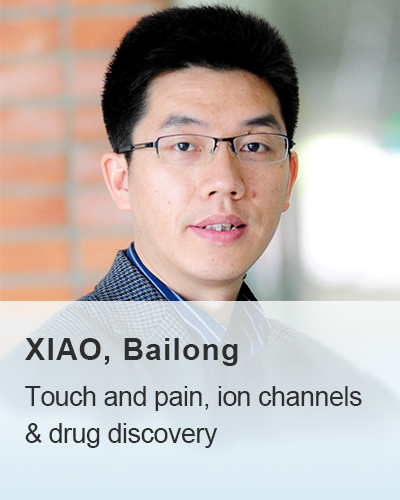 |
PI, IDG/McGovern Institute,Tsinghua University
PI, School of Pharmaceutical Sciences, Tsinghua University PI, Tsinghua-Beijing Universities Center for Life Sciences Office: Medical Sciences Building D407
Office Phone: 86-10-6277 3981 Lab Phone: 86-10-6277 3952 Email: xbailong@biomed.tsinghua.edu.cn |
[Research Focus]
Ion channels are fundamental membrane proteins that regulate the flow of ions across cell membranes and control cell excitability and function. Inappropriate channel activities caused by either mutations or abnormal physiological regulations underlie the etiology of numerous pathologies (collectively known as channel- opathies). Thus, an understanding of their structure and function is likely to lead to the development of new therapeutics. Our laboratory is interested in investigating the structure-function relationship, physiological and pathophysiological roles of the so-called sensory ion channels such as temperature-activated Transient Receptor Potential (TRP) channels (thermoTRPs), Calcium Release Activated Calcium (CRAC) channels, and the newly identified mechanically activated Piezo channels. These channels can function as receptors for touch stimuli including temperature, chemicals, and mechanical force, and consequently govern the sense of touch. By focusing on char acterizing known sensory channels and identifying novel ones, we aim to better understand the molecular and cellular mechanisms of the sense of touch and pain and other related physiological processes such as inflammatory responses with an ultimate goal of identifying novel therapeutics. Techniques employed in our research include molecular biology, biochemistry, single cell or high-throughput calcium imaging, electrophysiology, siRNA or compound library screening, generation and behavioral analysis of transgenic mice, etc. Positions for postdoctoral fellow, graduate student and technician are available in our laboratory.
Our current research focuses aim to 1) comprehensively characterize the newly identified mechanically activated Piezo channels; 2) unravel the physiological relevance of the thermosensitive STIM1/Orai-mediated CRAC channels; 3) identify novel mechanosensitive or thermosensitive ion channels/receptors.
[Education & Experience]
2013-Present PI, IDG/McGovern Institute,Tsinghua University
2013-Present PI, School of Pharmaceutical Sciences, Tsinghua University
2013-Present PI, Tsinghua-Beijing Universities Center for Life Sciences2007-2012 Postdoctoral Research Associate, The Scripps Research Institute
2007-2012 Visiting Scientist,Genomics Institute of the Novartis Research Foundation
2001-2006 Ph.D., Cardiovascular and Respiratory Sciences, University of Calgary
1997-2001 B.S., Dept. of Biochemistry, Sun Yat-Sen (zhongshan) University
[Selected Publications]
- Qiancheng Zhao, Heng Zhou, Shaopeng Chi, Yanfeng Wang, Jianhua Wang, Jie Geng, Kun Wu, Wenhao Liu, Tingxin Zhang, Meng-Qiu Dong, Jiawei Wang, Xueming Li*, Bailong Xiao*(2018) Structure and Mechanogating Mechanism of the Piezo1 Channel. Nature (Article) 2018 Feb 22;554(7693):487-492. doi: 10.1038/nature25743. Epub 2018 Jan 22.
- Yanfeng Wang, Shaopeng Chi, Huifang Guo, Guang Li, Li Wang, Qiancheng Zhao, Yu Rao, Liansuo Zu, Wei He, Bailong Xiao* (2018) A lever-like transduction pathway for long-distance chemical- and mechano-gating of the mechanosensitive Piezo1 channel. Nat Commun 2018 Apr 04.
- Tingxin Zhang, Shaopeng Chi, Fan Jiang, Qiancheng Zhao, Bailong Xiao* (2017). A protein interaction mechanism for suppressing the mechanosensitive Piezo channels. Nat Commun. 2017 Nov 27;8(1):1797.
- Yubo Wang, Bailong Xiao* (2017). The mechanosensitive Piezo1 channel: structural features and molecular bases underlying its ion permeation and mechanotransduction. J Physiol. 2018 Mar 15;596(6):969-978.
- Jie Geng, Qiancheng Zhao, Tingxing Zhang, Bailong Xiao* (2017). In Touch With the Mechanosensitive Piezo Channels: Structure, Ion Permeation and Mechanotransduction. Curr Top Membr. 2017;79:159-195.
- Qiancheng Zhao, Kun Wu, Jie Geng, Shaopeng Chi, Yanfeng Wang, Peng Zhi, Mingmin Zhang, Bailong Xiao*(2016). Ion Permeation and Mechanotransduction Mechanisms of Mechanosensitive Piezo Channels. Neuron. 2016 Mar 16;89(6):1248-63.
- Jingpeng Ge, Wanqiu Li, Qiancheng Zhao, Ningning Li, Maofei Chen, Peng Zhi, Ruochong Li, Ning Gao*, Bailong Xiao*, Maojun Yang(2015). Architecture of the mammalian mechanosensitive Piezo1 channel. Nature. Nov 5;527(7576):64-9.
- Bertrand Coste*, Bailong Xiao*, Jose S. Santos, Ruhma Syeda, Jorg Grandl, Kathryn S. Spencer, Sung Eun Kim, Manuela Schmidt, Jayanti Mathur, Adrienne E. Dubin, Mauricio Montal, Ardem Patapoutian (2012). Piezo Proteins Are Pore-forming Subunits of Mechanically Activated Channels. Nature. 2012 Feb 19;483(7388):176-81 PMID:22343900.
- Bailong Xiao*, Bertrand Coste, Jayanti Mathur, Ardem Patapoutian (2011). Temperature-dependent STIM1 activation induces Ca2+ influx and modulates gene expression. Nat Chem Biol. 2011 Jun;7(6):351-8. PMID: 21499266.
- Bailong Xiao*, Ardem Patapoutian (2011). Scratching the surface: a role of pain-sensing TRPA1 in itch. Nat Neurosci. 2011 May;14(5):540-2. PMID: 21522144 News & Views
- Bailong Xiao*, Adrienne E. Dubin, Badry Bursulaya, Veena Viswanath, Timothy J. Jegla, Ardem Patapoutian (2008). Identification of Transmembrane Domain Five as a Critical Molecular Determinant of Menthol Sensitivity in Mammalian TRPA1 Channels. J Neurosci. 2008 Sep 24;28(39):9640-51.
- Lindsey J. Macpherson*, Bailong Xiao*, Kelvin Y. Kwan (co-first), Matt J. Petrus, Adrienne E. Dubin, SunWook Hwang, Benjamin Cravatt, David P. Corey, Ardem Patapoutian (2007). An Ion Channel Essential for Sensing Chemical Damage. J Neurosci. 2007 Oct 17;27(42):11412-5.
- Bailong Xiao*, Xixi Tian, Wenjun Xie, Peter P. Jones, Shitian Cai, Xianhua Wang, Dawei Jiang, Lin Zhang, Keyun Chen, Michael P. Walsh, Heping Cheng, and S. R. Wayne Chen (2007). Functional Consequence of PKA-dependent Phosphorylation of the Cardiac Ryanodine Receptor: Sensitization of Store-overload-induced Ca2+ release (SOICR). J Biol Chem. 2007 Aug 10.
- Bailong Xiao*, Guofeng Zhong, Masakazu Obayashi, Dongmei Yang, Michael P. Walsh, Yakhin Shimoni, Heping Cheng, Henk ter Keurs, and S. R. Wayne Chen (2006). Serine-2030, but not Serine-2808, is the Major RyR2 Phosphorylation Site Responding to PKA Activation upon beta-adrenergic Stimulation in Normal and Failing Hearts. Biochem J. 2006 Feb 17.
- Bailong Xiao*, Ming Tao Jiang, Mingcai Zhao, Dongmei Yang, Cindy Sutherland, F. Anthony Lai, Michael P. Walsh, Heping Cheng, David C. Warltier, and S. R. Wayne Chen (2005). Characterization of a Novel Protein Kinase A Phosphorylation Site, Serine-2030, Reveals No PKA Hyperphosphorylation of the Cardiac Ryanodine Receptor in Canine Heart Failure. Circ Res. 2005 Apr 29;96(8):847-55.
- Bailong Xiao*, Cindy Sutherland, Michael P. Walsh, S. R. Wayne Chen (2004). Protein Kinase A Phosphorylation at Serine-2808 of the Cardiac Ca2+-Release Channel (Ryanodine Receptor) Does Not Dissociate 12.6-kDa FK506-Binding Protein (FKBP12.6). Circ Res. 2004 Mar 5;94(4):487-95.
- Bailong Xiao*, Haruko Masumiya, Dawei Jiang, Ruiwu Wang, Yoshitatsu Sei, Lin Zhang, Takashi Murayama, Yasuo Ogawa, F. Anthony Lai, Terence Wagenknecht, and S. R. Wayne Chen (2002). Isoform Dependent Formation of Heteromeric Ca2+ Release Channels (Ryanodine Receptors). J Biol Chem. 2002 Nov 1; 277(44): 41778-85.
